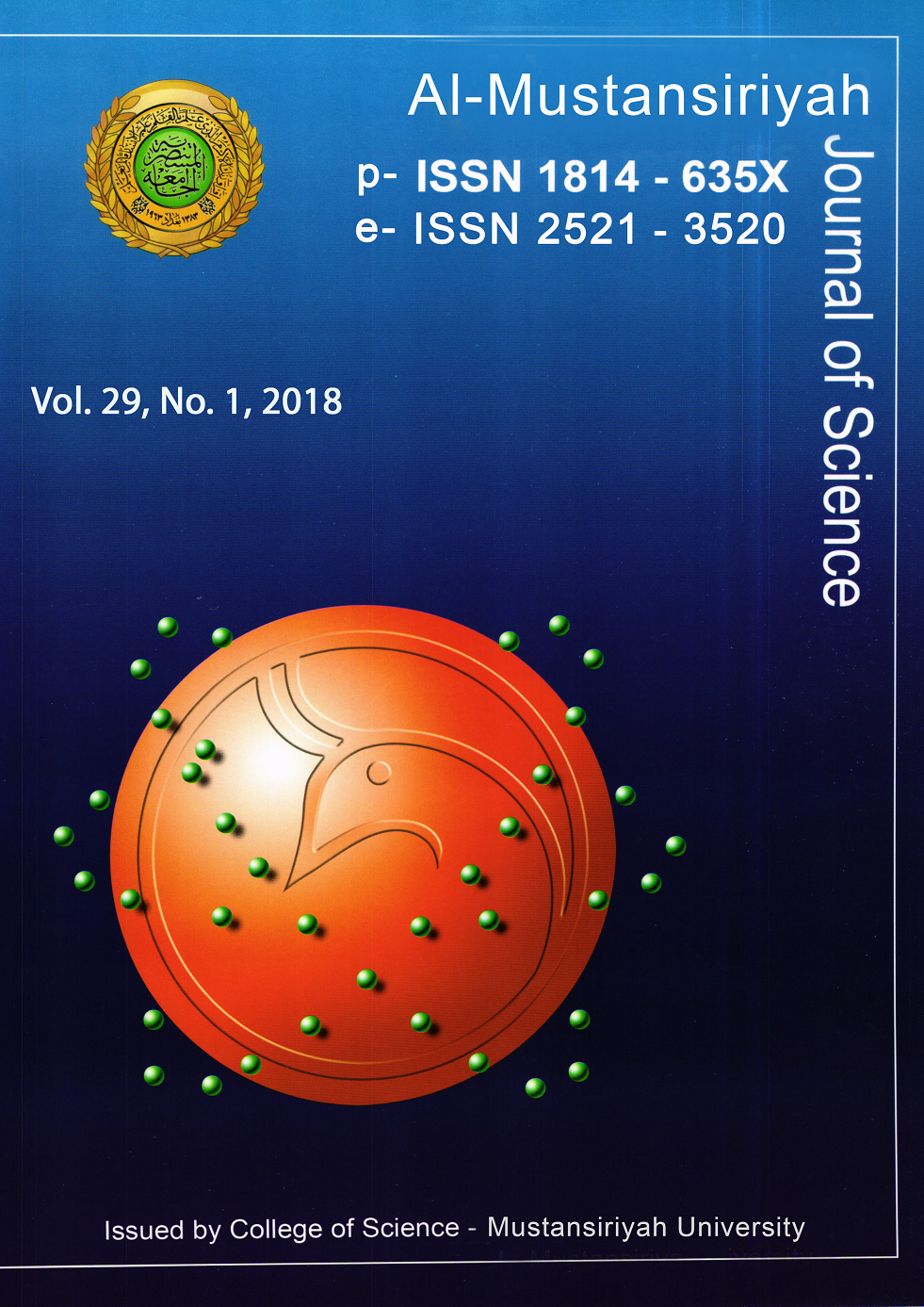Response of Pea (Pisum sativum L.) to foliar application of ABA and vitamin C and interaction of them on some physiological characters of plant
DOI:
https://doi.org/10.23851/mjs.v29i1.76Keywords:
Pea (Pisum sativum), ABA, Vitamin C.Abstract
The field experimental was conducted during the growth winter season of 2016-2017 at Botanical garden of Department of Biology, College of Education for Pure Science (Ibn Al-Haitham), University of Baghdad. The experimental aimed to study the effect of different of foliar application (0, 10, 20) mg.L-1 and vitamin C (0, 50, 100, 150) mg.L-1 and interaction of them on some physiological characters of pea (Pisum sativum L.). The results showed that ABA increased the proline and increased the vitamin C content at 10 mg.L-1. The vitamin C increased absolute growth rate (AGR), biomass duration, proline, vitamin C content compared with control plants.Downloads
References
Al-Kateb, Y. M. Classification of seed plants, first edition. Dar Al-Kuttab for Printing and Publishing, University of Mosul: 318 pages. 1988.
Matlob, A. N.; Ezz-El-Din, S. M. and Karim, S. A. Vegetable Production (Part 1). Dar Al-Kuttab for Printing and Publishing, University of Mosul, Iraq. 1980.
Verma, S. K. and Verma, M. T textbook of Plant Physiology, Biochemistry and Biotechnology. S. Chand & Company LTD. Ram Nager, New Delhi. 2008.
Jain, V. K. Fundamental of Plant Physiology. Cland & Company, LTD. Ram Nager, New Delhi. 2011.
Zhu, Y. D.; Zhaou, X.; Xia, Z.; Wen, S. Y.; Shen, J.; Ma, J.; Tu, C. and Fut, J. The role of abscisic acid in early the development. Plant Mol. Biol., 72: 1-2. 2010.
Kefelic, V. I. Vitamins and some other representative of non hormonal plant growth regulars, Priki. Biochem. Microbiol., 17: 5-15. 1981.
Quan, L. J.; Zhang, B.; Shi, W. W. and Li, H. Y. Hydrogen peroxide in plant. Versatile Molecule of oxygen species network. J. Intergr. Plant Biol., 50(1): 2-8. 2008.
Arrigoni, O. and De Tullio, M. C. Ascorbic acid much more than just an antioxidant. Biochem. Et Biochem. Acta, 1509: 1-9. 2002.
Ali, H. G.; Eis, T. A. and Jeda'an, H. M. Legume crops. Department of Field Crops, College of Agriculture, University of Baghdad, Press Higher Education and Scientific Research, Mosul. 1990.
Mnteith, J. L. Reassessment of maximum growth rates for C3 and C4 crops. Exp. Agric, 14: 1-5. 1978.
Kvent, J.; Svobal, J. and Fiala, K. Canopy development in stands of Typa latifa L. and Phraymites communis. Trin. South Maravid Hidro. Biologia, 10: 63-75. 1969.
Hussain, I.; Khan, M. A.; Khan, F. U.; Ayaz, S. and Khan, F. U. UV. Spectrophotometric analysis profile of ascorbic acid in medical plant of Pakistan. World Appl. Sci. J., 9(7): 800- 803. 2010.
Bates, l. S.; Waldron, R. P. and Tears, J. D. Rapid determinates of free proline for water stress studies. Plant and Soil, 39: 205-207. 1973.
SAS. Statistical Analysis System. Users Guide. Statistical-Version 9.1th ed. SAS. Inst. Inc. Cary. N.C. USA. 2012.
Magnon, M.; Bruzzone, S.; Guide, G.; Darnonte, E.; Searfis, C.; Sturia, L.; Palomba, D.; Deflora, D. and Zocch, A. Abscisic acid released by human monocytes activates and Vascular smooth muscle cell responses involved in atherogenesis. J. Biol. Chem., 284(26). 2009.
Nambara, E. and Marion-Poll, A. Abscisic acid biosynthesis and catabolism. Ann. Rev. Plant Biol., 56: 165-185. 2005.
Al- Fattalawi, S. K. A-A. Effect of application of ABA in growing Triticum aestuim L. growing under different levels of water stress. Master Thesis, College of Education for Pure Sciences / Karbala University. 2013.
Turkan, I. and Demiral, T. Recent development understanding salinity. Environ. Exp. Bot., 67: 2-9. 2009.
Bano, A. and Samina, Y. Role of phytohormones under induced drought stress in a Wheat. Pak. J. Bot., 42(4): 2579-2587. 2010.
Khan, T. A.; Majid, M. and Mohammed, F. Ascorbic acid: an enigmatic molecule to developmental and environmental stress in plant. Int. J. Appl. Biol. Pharm. Tech., 2(3): 468-483. 2011.
Amin, A. A.; Rashad, El-Sh. M. and Gharib, F. A. E. Chary in morphological, physiology, and reproductive characters of wheat plants as affected by foliar application with salicylic acid and ascorbic acid. Auster. J. Basic and Appl. Sci., 2(2): 252-261. 2008
El-Awadi, M. F.; El-Lethy, S. K. and El-Rokick, K. G. Effect of the two antioxidant, glutathione and Ascorbic acid on vegetative growth, yield and some biochemical changes I two wheat cultivars. Plant Sci., 2(5): 215-221. 2014.
Gupta, S. D. Reactive oxygen species and antioxidant in higher plant. J. Stress Physiol. Biochem., 6(3): 64-90. 2011.
Johari-Pirvattou, M.; Qasimov, N. and Maralian, H. Effect of soil water stress on yield and proline content of four wheat times. Agri. J. Biotech., 9:36-40. 2010.
Al-Arkawazi, A. L. A. Effect of foliar application of hydrogen peroxide and vitamin C on growth and yield of two cultivars of (Hordeum vulgare L.) planted in the dry farming land. PhD thesis, College of Education for Pure Sciences (Ibn Al-Haitham), Baghdad University. 2016.
Zhwan, K. H. and Khursheed, M. Q. Effect of foliar application of ascorbic acid on growth, yield components and some chemical constituents of wheat under water stress conditions, Jord. J. Agric. Sci., 10(1): 1-15. 2014.
Downloads
Key Dates
Published
Issue
Section
License
(Starting May 5, 2024) Authors retain copyright and grant the journal right of first publication with the work simultaneously licensed under a Creative Commons Attribution (CC-BY) 4.0 License that allows others to share the work with an acknowledgement of the work’s authorship and initial publication in this journal.






















